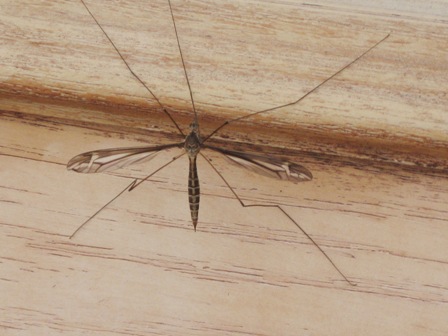Where Science, Art and Nature Come Together.
Morning Visitor
 This little guy was waiting for me when I got to the office this morning. He was right in the center of the door, so with a wingspan of more than 2″ was hard to miss.
This little guy was waiting for me when I got to the office this morning. He was right in the center of the door, so with a wingspan of more than 2″ was hard to miss.
I’ve grown up calling these critters mosquito hawks; their more correct name is crane fly (genus Tilupa, with many different species). To my eye, they look a bit like a winged daddy long legs and a bit like a mosquito. I’m guessing it’s that latter similarity that gave them their common name. Why the hawk part? Sure beats me!
It’s pretty common that folks think that mosquito hawks eat mosquitos. Unfortunately, this is not true. Like many adult insects, crane flies don’t usually eat during their short time spent in this phase of their lives. If they do dine, it’s on flower nectar. They don’t bite people, pets, or livestock, and have never been shown to carry disease.
Crane fly larvae munch on decaying plants, dead leaves, fungi, and plant roots. So unless they’re dining on your prized garden plants (not all that common since most species are aquatic), they’re no trouble. They do like grass roots, so if you have a lot of them in your lawn, that may present a bit of a problem. I solve that one by having plenty of weeds (dandelions, clovers, sedges, and more) growing amidst my grass, and as long as it’s green, it’s fine by me.
Crane flies spend most of their time near the water. Their few days as adults are spent in that eternal quest to reproduce themselves. Cruising for chicks is their primary concern. So what was this guy doing on the door of our office on Main Street? (Actually, I have no idea if it was a male seeking a female or vice versa.)
With Dodge Creek only a few hundred yards away he was probably flying around looking for love. Then he got confused by all the bright lights downtown, and after swinging around the street lights for a while, got tired and had to take a rest. Being made of wood, our door seemed as good a place as any.
He wasn’t there for long. By the time the next person came in about 45 minutes later, Mr. Crane Fly was nowhere to be seen.
Back to those pesky mosquitos, if you want an easy, all-natural way to control them and other flying insects, get yourself a bat house. Bats can eat up to 2,000 insects a night! If you missed our Build A Bat House workshop, we can sell you either the parts to make your own at home or a completed house ready for you to paint & hang. Call the office (716.933.0187) for more info on a bat house.
Your turn: what interesting bugs have you seen lately?